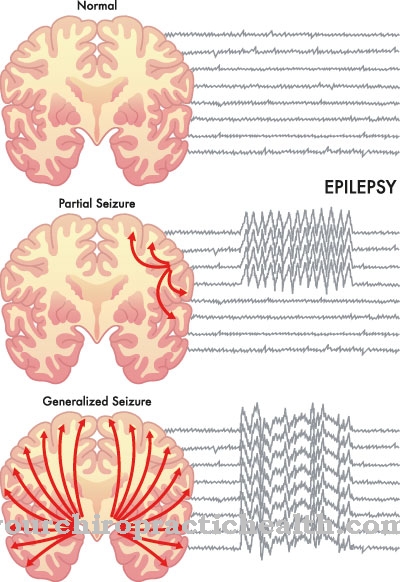Analgesics are substances that have analgesic or analgesic effects. Analgesics are also known as pain relievers.
What are analgesics?

Various can be subdivided Analgesics for example with regard to their place of action: while so-called peripherally effective analgesics only affect the periphery of the body, centrally effective analgesics influence structures of the central nervous system.
Furthermore, analgesics can be distinguished in terms of their potency: In addition to weakly effective analgesics, some of which are available over the counter in pharmacies, there are weakly effective analgesics that have a central effect. These active ingredients include, for example, various low-concentration opiates.
Strongly effective, centrally acting analgesics include highly concentrated opiates. When dividing into weak and strong analgesics, it should be noted that the strength of the effect is determined not only by the preparation but also by the respective dosage.
Application & use
Be in medicine Analgesics used to combat acute and chronic pain conditions. With regard to their application, so-called non-topioid analgesics can be distinguished from opioid analgesics. Non-opioid analgesics (also referred to as non-narcotic analgesics) are used in the treatment of mild to moderate pain, usually by reducing the sensitivity of various pain receptors in the body.
Typical complaints treated in this way include toothache, headache (tension and migraine headache) or menstrual pain. Some non-opioid analgesics are also suitable for combating fever, which can be associated with flu-like infections, for example. If non-opioid analgesics are dosed higher, they can also be used to treat rheumatic pain. Some analgesics of the non-opioid group of drugs can also be used to reduce inflammation.
Opioid analgesics (also known as narcotic analgesics) are primarily used to combat severe pain. Corresponding analgesics are used, for example, against colic pain (cramp-like pain that extends over the abdomen), against pain caused by cancer or against pain caused by accidents.
Furthermore, opioid analgesics are used during surgical interventions or for pain relief after such interventions.
Herbal, Natural & Pharmaceutical Analgesics
Analgesics come in different forms; In addition to the chemical-pharmaceutical preparations, there are, for example, pain-relieving agents on a natural or herbal basis. Various herbal analgesics can be used internally (for example in the form of teas or extracts) or externally (for example through ointments or compresses) depending on the active complex.
Some herbal analgesics are reported to have a so-called surge phase before they fully develop to relieve pain, which can take a few days. In such a surge phase, the body should be sensitized to its effectiveness. Depending on the individual herbal analgesics, their effectiveness is not always scientifically proven.
The same applies to analgesics that are used in homeopathy. According to homeopathy, various homeopathic remedies can act as analgesics, depending on the individual and the symptoms. These remedies can either be absorbed through so-called globules, drops or tablets.
In addition to the analgesics mentioned, especially in pain therapy, so-called placebos (dummy drugs that contain no active ingredients) have also been scientifically proven to be effective. In the psyche of many people, placebos can serve as analgesics insofar as they can positively influence both subjective pain perception and pain processing at the level of the central nervous system.
You can find your medication here
➔ Medicines for painRisks & side effects
Risks associated with taking Analgesics are connected depend, among other things, on the respective group of active substances and also on the dose and the period of ingestion or use. For example, herbal analgesics can cause intolerance.
If some of these analgesics are dosed incorrectly, they can also have a toxic (poisonous) effect on humans. Side effects that can appear after prolonged use of peripheral chemical analgesics are mainly gastrointestinal problems or damage or ulcers of the gastric mucosa.
Possible side effects of opioid analgesics are, among other things, their potential for addiction and a potential limitation of the respiratory rate. In general, analgesics may also not be suitable if there are various diseases or if other medications are being taken at the same time. In the latter case, for example, undesirable interactions can occur.




.jpg)



















.jpg)



